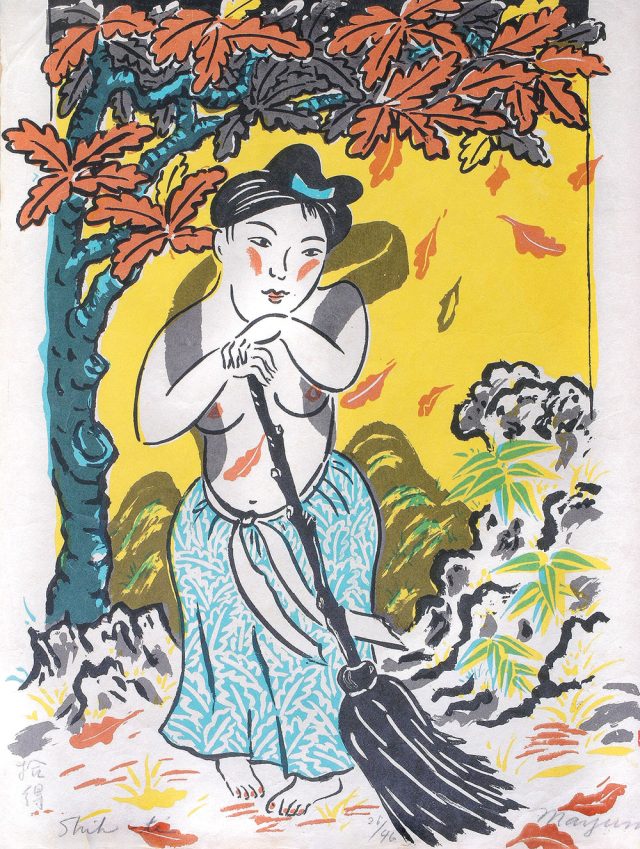At 76 years old, Mayumi Oda, known as the “Matisse of Japan” for her bold paintings and screenprints of goddesses, female bodhisattvas, and poets and her lush depictions of vegetable and plant life, is among the most successful female Japanese artists of her generation. Oda, also well known for her antinuclear activism and Zen teaching, has artistic work held in the permanent collections of the Museum of Modern Art in New York, the Library of Congress in Washington, D.C., the Museum of Fine Arts in Boston, the Osaka Modern Art Center in Japan, and elsewhere, and she has had more than 50 solo shows around the world.
Mayumi was born and raised in Kyodo, a suburb of Tokyo. She studied fabric arts at the Tokyo University of Fine Arts before moving to New York with her American husband in 1966. There she met many famous male artists of the day, which resulted in her personal awakening as a female artist: she began creating pieces that featured vibrant, colorful feminine figures, often reimagining typically male cultural and religious characters.
Later, while living in Massachusetts, Mayumi developed a simple silkscreen technique that she would use throughout her career. Utilizing oil-based ink and water-soluble glue, she sealed areas of silk stretched over wood frames. In old cookie tins she mixed colored ink with a transparent printing medium and applied a thin surface of the blend to the silk before transferring the image onto Japanese mulberry paper. The result mimicked the style of ukiyo-e works, prints and paintings popular in Japan from the 17th to the 19th century whose subjects included courtesans and wrestlers, landscapes and plant life, as well as Kabuki actors from classical Japanese theater, beautiful women, and erotica.
Mayumi spent a year in Japan in the late ’70s with her husband and two sons, and there she began to practice zazen. When she returned to the United States, she moved in next door to the Zen community at Green Gulch Farm in Muir Beach, California, where she produced many of her most sought-after silkscreen prints in a small backyard studio. In 2000, she bought land in Hawaii and started Gingerhill Farm Retreat, a vast garden paradise that serves family, friends, and the local community.
Mayumi’s vision, feminism, and commitment to Zen practice are apparent in Divine Gardens: Mayumi Oda and the San Francisco Zen Center (Parallax Press, 2017), from which the portfolio on the following pages was taken. In these pieces, Mayumi replaces the traditional ukiyo-e images of courtesans and Kabuki actors with female poets, while monks and male Zen bodhisattvas are transformed into voluptuous female goddesses. Outsize vegetables from the garden of life and death represent the wheel of the dharma. Perfect Wisdom Bodhisattva, usually depicted riding a ferocious lion that represents the tamed mind, instead appears as a Manjushri goddess riding a bicycle—a symbol of women’s liberation— while holding a sutra overhead. In Winter Sky, an oversize squash enjoys the reflected light of Mount Tamalpais; Beet raises exuberant leaves toward the last rays of a sun setting over Green Gulch Farm and the Pacific Ocean. Two legendary Tang dynasty poets, Han-Shan and his sidekick Shih-Te, thought to be emanations of the bodhisattvas Manjushri and Samantabhadra, are here painted as women. Han-Shan, the author of Cold Mountain Poems, delights in the moonlight and freshly written verse while her friend and monk, Shih-Te, takes a moment to rest during work-practice, sweeping leaves on a crisp fall day.
—Lane Olson, Faculty Emerita, California State University, Sonoma County




Thank you for subscribing to Tricycle! As a nonprofit, we depend on readers like you to keep Buddhist teachings and practices widely available.
